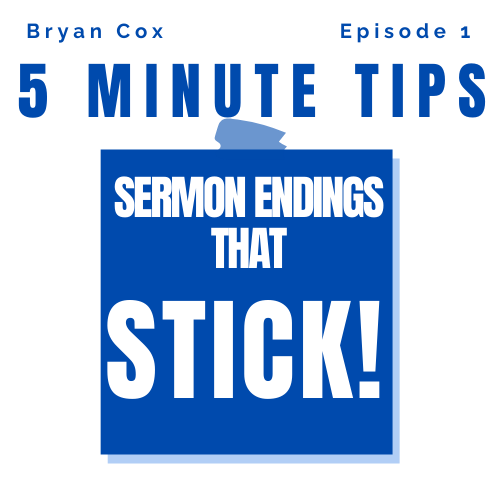The Monday Morning Sermon: Making Your Message Last

Monday Morning Sermon:
Welcome to the blog! In this post, we're diving deeper into a concept we explored in our latest podcast episode: how to craft sermon endings that create lasting impact. We'll be unpacking the idea of 'Monday moments' and equipping you with practical techniques to ensure your message resonates with your congregation long after the Sunday service. This builds upon the conversation we had in our most recent episode, "(Bonus) Sermon Endings That Stick", where we discussed a simple shift in approach to transform your sermons from informative to transformative. Let’s explore the challenge, understand the problem, and then delve into creating those crucial 'Monday moments'.
Introduction: The Monday Morning Sermon Challenge
Every pastor and preacher has experienced it: the feeling that your Sunday sermon, carefully crafted and passionately delivered, somehow loses its potency by Monday morning. The energy in the room dissipates, the inspiration fades, and the intended impact on your congregation's lives seems to diminish. It's the 'Monday Morning Sermon Challenge' – how do we, as communicators of truth, ensure that our messages don't just inform, but truly transform, our listeners' lives, impacting their decisions and actions throughout the week?
The truth is, many sermons, while well-intentioned and theologically sound, lack a clear bridge from the sanctuary to the everyday realities of life. They may inspire, they may educate, but they often fail to equip people with the practical tools they need to apply the message to their Monday morning challenges. This disconnect is what we need to address.
The Problem: Sermons That Evaporate by Monday
Why do so many sermons evaporate by Monday? There are several contributing factors. One is the sheer volume of information that people are bombarded with daily. Our brains are wired to filter out what seems irrelevant or non-urgent, and unless a sermon specifically addresses a felt need or provides a clear path to action, it's likely to be relegated to the mental background noise.
Another factor is the passive nature of listening. People are often in a receptive mode during a sermon, absorbing information but not actively processing how to integrate it into their lives. Without specific prompts or instructions, the message remains theoretical, existing in the realm of ideas rather than practical application.
Furthermore, the emotional high of a worship service can create a temporary sense of conviction that fades with the return to the daily grind. The pressures of work, family, and personal struggles can quickly overshadow the spiritual insights gained on Sunday. It's not that people don't want to change; it's that they lack the practical tools and motivation to sustain that change in the face of real-world challenges.
Finally, many sermons are simply too abstract. They deal with complex theological concepts or broad moral principles without providing concrete examples of how those principles apply to everyday situations. People need to see the connection between the sermon's message and their own lives in order to translate inspiration into action. What does forgiveness look like when your neighbor is actively spreading rumors about your family? What does loving your enemy look like when that enemy is your boss? These are the kinds of specific, practical applications that are often missing from sermons.
Personal Anecdote: The 'Light of the World' Sermon
One time I preached a sermon on Jesus’ words, “You are the light of the world.” I felt great about it! I talked with passion about God’s light, giving hope, and showing God’s love through doing good for others. People seemed to listen, and many said nice things afterward.
But the next day, I saw a woman from church at the grocery store. I asked how she was doing. She said, “Fine, just trying to get through the week.” I asked her if she enjoyed the message on Sunday. She thought for a moment and said, “It was a good sermon, very inspiring.”
Her answer hurt me a little. She wasn’t being mean—it just showed me that even though she was inspired, she didn’t know what to do with the message. I had told her what it means to be the light, but not how to live it out on Monday morning.
That moment changed me. From then on, I worked harder to make my sermons clear and practical so people don’t just hear the message, but also know how to live it every day.
The Solution: Ending Sermons with Purpose
The solution to the 'Monday Morning Sermon Challenge' lies in ending sermons with purpose. This means intentionally crafting sermon conclusions that are not merely summaries of the main points, but rather a call for action. It involves providing clear, specific, and achievable steps. Steps listeners can take to apply the message throughout the week.
Instead of simply restating the sermon's theme, focus on translating the message into practical behaviors and attitudes. What specific actions can people take to live out the principles you've discussed? What challenges might they encounter, and how can they overcome them? What resources can you provide to support their efforts?
A purposeful sermon ending is not an afterthought; it's an integral part of the message. It's the bridge that connects Jesus to the world, the link that transforms inspiration into action. It's the key to creating 'Monday moments' that lead to lasting life change.
Creating 'Monday Moments' for Lasting Impact
'Monday moments' are those instances throughout the week when the sermon's message resurfaces in your listeners' minds, influencing their decisions and actions. They are the moments when the truth you proclaimed on Sunday becomes a living reality in their lives. Creating these moments requires intentionality and a strategic approach to sermon endings.
One effective technique is to provide a specific, concrete challenge for the week. Instead of simply encouraging people to "be kinder," challenge them to perform one specific act of kindness each day. Instead of urging them to "pray more," challenge them to set aside five minutes each morning for prayer and meditation. The more specific the challenge, the more likely people are to take action.
Another technique is to provide a memorable phrase or image that encapsulates the sermon's message. This phrase or image can serve as a mental trigger, reminding people of the key principles throughout the week. For example, instead of simply saying, "God loves you," you might say, "You are God's beloved masterpiece." This kind of evocative language is more likely to stick in people's minds.
Furthermore, it's important to anticipate the challenges that people might face in applying the message to their lives. Acknowledge the difficulties and provide practical strategies for overcoming them. For example, if you're preaching on forgiveness, acknowledge that forgiveness is not always easy and provide practical steps for processing anger and resentment.
Finally, encourage accountability. Encourage people to share their challenges and successes with others, to find a prayer partner, or to join a small group. Accountability can provide the support and encouragement needed to sustain change over time.
Practical Tips for Actionable Takeaways
Here are some practical tips for creating actionable takeaways in your sermon endings:
- Use the "So What?" Test: Before finalizing your sermon ending, ask yourself, "So what? What difference does this message make in people's lives?" If you can't answer that question clearly and concisely, your sermon ending needs more work.
- Provide Specific Instructions: Don't just tell people what to do; tell them how to do it. Break down complex tasks into smaller, more manageable steps.
- Use Concrete Examples: Illustrate your points with real-life examples that people can relate to. Show them what the message looks like in action.
- Anticipate Objections: Address potential obstacles and provide solutions. Show people that you understand their challenges and that you're committed to helping them overcome them.
- Keep it Simple: Don't overload people with too many instructions. Focus on one or two key takeaways that they can realistically implement in their lives.
- Make it Measurable: Encourage people to track their progress. This can provide a sense of accomplishment and motivation to continue.
- Offer Resources: Provide practical resources such as books, articles, websites, or support groups that can help people deepen their understanding and apply the message to their lives.
- End with a Question: Pose a thought-provoking question that encourages people to reflect on the message and consider how it applies to their own lives.
For example, instead of saying "Go and serve others this week," you could say, "This week, identify one person you can serve in a practical way, like helping a neighbor with yard work or volunteering at a local soup kitchen. What's one specific action you can take to serve others and show them God's love?"
Transforming Sermons: From Informative to Transformative
The shift from informative sermons to transformative sermons requires a change in mindset. It's about moving beyond simply imparting knowledge to actively facilitating life change. It's about seeing your role not just as a speaker, but as a catalyst for transformation.
This transformation begins with prayerful preparation. Ask God to show you how your message can impact people's lives in a practical way. Seek His guidance in crafting sermon endings that are both inspiring and actionable.
It also requires a deep understanding of your congregation. What are their struggles? What are their aspirations? What are their felt needs? The more you know about your listeners, the better equipped you'll be to craft messages that resonate with their hearts and minds.
Finally, it requires a willingness to experiment and learn. Don't be afraid to try new approaches to sermon endings. Seek feedback from your congregation and be open to making adjustments based on their input. The goal is to continually refine your craft so that you can more effectively communicate God's truth and empower people to live it out in their everyday lives.
Call to Action: Share and Support the Podcast
We hope this blog post has provided you with valuable insights and practical tips for crafting sermon endings that create lasting impact. Remember, the goal is not just to inform, but to transform – to create 'Monday moments' that lead to genuine life change.
If you found this information helpful, please share this blog post with your pastor friends and colleagues. And don't forget to listen to our latest podcast episode, "(Bonus) Sermon Endings That Stick", for even more in-depth discussion and practical examples.
We also invite you to support the Speak on Purpose podcast. Your support helps us continue to create valuable content that equips preachers and communicators to share their messages with clarity, confidence, and impact. You can find links to support the podcast on our website. Thank you for your partnership in spreading God's word!
Remember, your words have the power to speak life and bring transformation. Let's use them intentionally and purposefully to create 'Monday moments' that resonate throughout the week and beyond.







